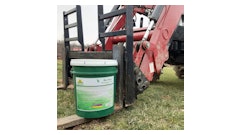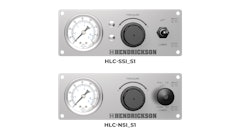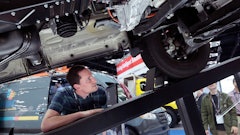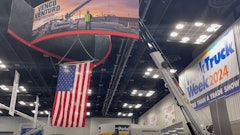
There was a day when field fueling and service was a two-option proposition: either you got by with small containers and diesel nurse tanks in the back of pickup trucks or you were big enough to own a full-sized fuel or service rig. There was very little in the way of in-between solutions that weren’t homemade, unroadworthy, or otherwise unreliable.
And sure, you can hire out some fueling and field service activities, but that puts you at the mercy of the schedules of other service providers — which isn’t always convenient, particularly if your fleet operates on weekends, over holidays, or in remote areas.
The solution: there are now products on the market—in both trailer-mounted configurations and medium duty work truck upfits—that allow you to deliver bulk diesel, DEF, grease and other service fluids to the jobsite, that don’t require employees with additional driver’s license certifications or endorsements, require a smaller upfront investment than larger solutions, and allow each business owner/fleet manager to control their own destiny.
No HAZMAT, No CDL
Both the trailer-mounted designs and the work truck upfits allow for the transport of bulk diesel and other daily fluids without requiring the driver to have a HAZMAT endorsement on their license and may also not require a CDL (depending on the combination of truck and trailer). This is accomplished by compartmentalizing the diesel (and other fluids/oils) in tanks that hold fewer than 119 gallons—the most volume allowed in a single compartment for select fluids. In the case of diesel, each compartment connects to a common manifold for fueling. Models that allow for a combination of varied fluids (diesel, engine oil, hydraulic oil, waste oil reclaim, etc.) for daily service feature completely independent storage tanks, lines and pumping apparatus.
These solutions allow businesses to take on their own bulk fluid transportation where in the past they may have not wanted to invest in larger service trucks.
Lower Cost of Entry, Carrying Costs
Businesses that have considered their own service or bulk fuel trucks in the past may have been dissuaded by both the initial purchase price of the truck, the increased labor costs of drivers with HAZMAT endorsements and CDLs, as well as the greater owning and operating costs that come with big trucks (upkeep, insurance, wear and tear, etc.).
The trailered versions of these solutions can haul up to 920 gallons of diesel (and combinations of other fluids), be pulled behind the pickup trucks/work trucks you already own, and cost a fraction of the investment of a full-sized fuel or service truck.
The medium-duty truck upfits are also considerably less expensive at the time of purchase and maintain similarly lower lifetime owning and operating costs.
Accessibility
Delivering bulk diesel and service fluids to wide-open jobsites is easy and can be done by trucks of all sizes — but these more compact solutions allow for greater access to jobsites in urban areas and otherwise “compact” jobsites where wheeling in a large truck doesn’t make sense. Particularly, in the case of the medium-duty work truck upfits, that vehicle can drive point-to-point around the jobsite and fill up and service equipment. Driving a truck of this size through urban traffic and accessing crowded jobsites is also much easier with a medium-duty truck than with a 3-4,000-gallon tanker.
The trailered versions can also be detached, giving you the freedom to leave the trailer on the jobsite and travel more freely with a pickup truck — which is obviously not possible with a much larger fuel or service truck.
Time Savings and Lack of Waste
For contractors who have relied on 100-gallon diesel nurse tanks in the back of pickup trucks, 2-gallon jugs of DEF, tubes of grease, and jugs of oil and coolant rather than a centralized fluids platform due to it being cost prohibitive—these newer solutions are much more practical to deploy within their fleets. And when you look at the time and resource savings that are possible when having these solutions on-site and on-demand, the practical return on investment becomes apparent:
- Fewer trips to and from gas stations throughout the week and fewer stops on your way to and from the jobsite
- No downtime: fuel and fluids available on demand
- Cost savings tied to buying fluids in bulk vs. buying them in individual packaging
Which brings up a great point about waste: for many of these fluids, having them in bulk means acquiring, storing, and disposing of many smaller packages and containers. These newer, service-oriented, centralized solutions allow you to eliminate the management, hassle, and cost of all of those smaller packages, as well as the physical waste that comes along with it.
Control Your Own Destiny
Business today is all about streamlining and efficiency–squeezing every bit of value out of a project while keeping productivity moving forward. Owning and operating your own fluid and service platform ensures that you have access to the fluids you need at all times and are never at the mercy of a service provider’s schedule. You also have greater control over the sourcing and quality of the fluids you’re putting into your equipment, which provides added peace of mind.
Utility/Versatility
The trailers, particularly, offer a level of customization and versatility that allow for each user to add things important to their business. The front compartment, in addition to housing the DEF system, can include space for toolboxes, additional oil tanks and storage. Optional rear utility boxes can include full greasing systems, toolboxes, welders, generators, air compressors, and more. One of the most popular options available is a light tower, which ensures that you can work on your equipment at any time of day. Other options like waste oil reclaim systems make changing oil and fluids in the field much easier than in the past.
When weighed together, the field fueling and service landscape has evolved to a place where contractors and fleet managers should feel empowered to grab the bull by the horns and control more of the sourcing and distribution of critical daily fluids and service needs. It’s never been more practical, more cost effective, and more profitable to operations.

























